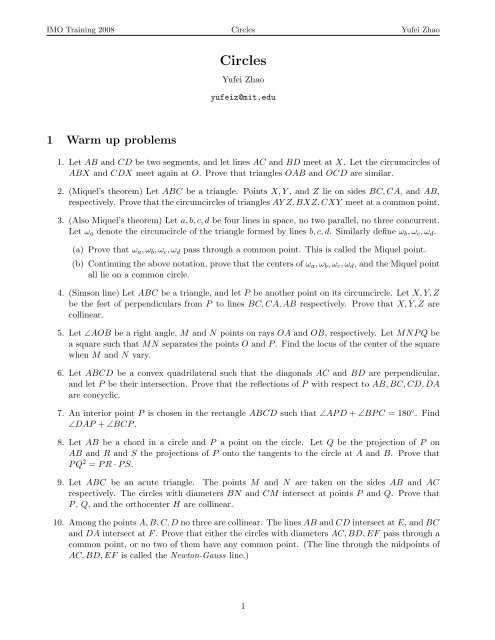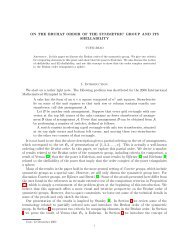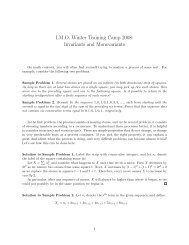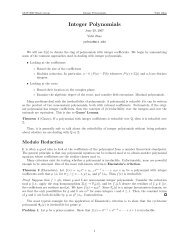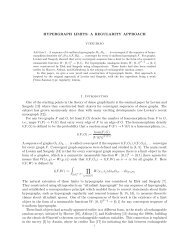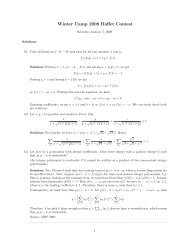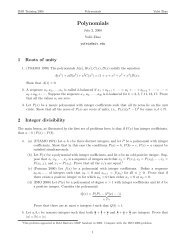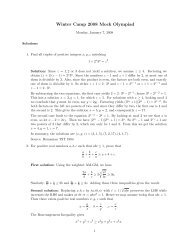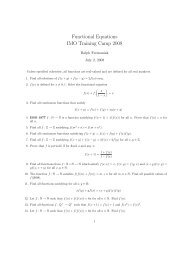Circles - Yufei Zhao
Circles - Yufei Zhao
Circles - Yufei Zhao
- No tags were found...
You also want an ePaper? Increase the reach of your titles
YUMPU automatically turns print PDFs into web optimized ePapers that Google loves.
IMO Training 2008 <strong>Circles</strong> <strong>Yufei</strong> <strong>Zhao</strong><strong>Circles</strong><strong>Yufei</strong> <strong>Zhao</strong>yufeiz@mit.edu1 Warm up problems1. Let AB and CD be two segments, and let lines AC and BD meet at X. Let the circumcircles ofABX and CDX meet again at O. Prove that triangles OAB and OCD are similar.2. (Miquel’s theorem) Let ABC be a triangle. Points X, Y , and Z lie on sides BC, CA, and AB,respectively. Prove that the circumcircles of triangles AY Z, BXZ, CXY meet at a common point.3. (Also Miquel’s theorem) Let a, b, c, d be four lines in space, no two parallel, no three concurrent.Let ω a denote the circumcircle of the triangle formed by lines b, c, d. Similarly define ω b , ω c , ω d .(a) Prove that ω a , ω b , ω c , ω d pass through a common point. This is called the Miquel point.(b) Continuing the above notation, prove that the centers of ω a , ω b , ω c , ω d , and the Miquel pointall lie on a common circle.4. (Simson line) Let ABC be a triangle, and let P be another point on its circumcircle. Let X, Y, Zbe the feet of perpendiculars from P to lines BC, CA, AB respectively. Prove that X, Y, Z arecollinear.5. Let ∠AOB be a right angle, M and N points on rays OA and OB, respectively. Let MNP Q bea square such that MN separates the points O and P . Find the locus of the center of the squarewhen M and N vary.6. Let ABCD be a convex quadrilateral such that the diagonals AC and BD are perpendicular,and let P be their intersection. Prove that the reflections of P with respect to AB, BC, CD, DAare concyclic.7. An interior point P is chosen in the rectangle ABCD such that ∠AP D + ∠BP C = 180 ◦ . Find∠DAP + ∠BCP .8. Let AB be a chord in a circle and P a point on the circle. Let Q be the projection of P onAB and R and S the projections of P onto the tangents to the circle at A and B. Prove thatP Q 2 = P R · P S.9. Let ABC be an acute triangle. The points M and N are taken on the sides AB and ACrespectively. The circles with diameters BN and CM intersect at points P and Q. Prove thatP , Q, and the orthocenter H are collinear.10. Among the points A, B, C, D no three are collinear. The lines AB and CD intersect at E, and BCand DA intersect at F . Prove that either the circles with diameters AC, BD, EF pass through acommon point, or no two of them have any common point. (The line through the midpoints ofAC, BD, EF is called the Newton-Gauss line.)1
IMO Training 2008 <strong>Circles</strong> <strong>Yufei</strong> <strong>Zhao</strong>2 Tangent circlesIn this section, we explore the following two configurations. 11. Let chords AC and BD of a circle ω intersect at P . A smaller circle ω 1 is tangent to ω at T andto segments AP and DP at E and F respectively.BCPEFDAT(a) Prove that ray T E bisects arc ABC of ω.(b) Let I be the incenter of triangle ACD and M be the midpoint of arc ABC of ω. Prove thatMA = MI = MC.(c) Let F ′ be the common point of ω 1 and line EI other than E. Prove that I, F ′ , D, T areconcyclic.MCEIF'DA(d) Prove that DF ′ is tangent to ω 1 . This means that F = F ′ , so that E, F, I are collinear.(Remember this fact.)(e) Let J be the incenter of triangle AP D. Prove that T, D, F, J are concyclic.1 Thanks to Oleg Golberg for providing some of these problems.T2
IMO Training 2008 <strong>Circles</strong> <strong>Yufei</strong> <strong>Zhao</strong>BCPEJFDAT(f) Prove that ray T J bisects angle AT D.2. Now we consider a special case of the part (d) in the previous problem. Try to find a short proofof the following result. (Hint: use Pascal’s theorem)Let ABC be a triangle and I its incenter. Let Γ be the circle tangent to sides AB, AC, as wellas the circumcircle of ABC. Let Γ touch AB and AC at X and Y , respectively. Show that I isthe midpoint of XY .ABXIYC3. Let Ω be the circumcircle of ABC. A circle ω is tangent to sides AB, AC and circle Ω at pointsX, Y and Z, respectively. Let M be the midpoint of the arc BC of Ω which does not contain A.Prove that lines XY , BC and ZM have a common point.(Can you prove the result when Ω only passes through B and C and contains A in the interior?)4. A circle ω is tangent to sides AB, AC of triangle ABC and to its circumcircle at points X, Yand Z. Segments AZ and XY meet at T . Prove that ∠BT X = ∠CT Y .5. (Sawayama-Thébault) Let ABC be a triangle with incenter I. Let D a point on side BC. LetP be the center of the circle that touches segments AD, DC, and the circumcircle of ABC, andlet Q be the center of the circle that touches segments AD, BD, and the circumcircle of ABC.Show that P, Q, I are collinear.3 Projective quickiesWarning: The introductory text in this section is very rough. It is not meant for you to learn from.Rather, I assume that you already know the basics of projective geometry, and this should serve as aquick review of the important concepts.You should be familiar with the notion of pole and polar. A quick definition is as follows:3
IMO Training 2008 <strong>Circles</strong> <strong>Yufei</strong> <strong>Zhao</strong>Definition. Suppose that ω is a circle with center O, and P and P ′ are inverses respect to ω (i.e., P ′lies on ray OP such that OP · OP ′ = r 2 , where r is the radius of ω). Let l be the line through P ′perpendicular to OP . Then we say that l is the polar of P and P is the pole of l.Here are a few diagrams that may help you to remember the common setups of poles and polars.polarpolepolepolepolepolarpolarpolarMake sure that you understand the duality behind poles and polars. If you need to prove that somethingis true, it suffices to prove its polar dual. The polar map transforms points to lines, lines to points. Ittransforms the intersection of two lines to the line joining the two points, and vice-versa. For instance:• To show that line l passes through point P , it suffices to show that the pole of l lies on the polarof P .• To show that three points are collinear, it suffices to show that their poles are concurrent.The cross ratio of four collinear points A, B, C, D is defined as(A, B; C, D) =AC · BDAD · BCwhere the lengths are directed. Cross ratios are preserved under projective transformations. (Besidescoincidence, this is pretty much the only thing that’s projective-invariant.)The most significant case is when (A, B; C, D) = −1, in which case we say that (A, B; C, D) is harmonic.This notion of cross ratios and harmonic quadruples is not limited to collinear points, but also appliesto pencils of lines, and concyclic points. Harmonic quadruples arise frequently, so learn to recognizethem!Possibly the most useful fact from polar geometry is the self-polarity of the diagonal triangle of acyclic quadrangle. (Part of the reason why it’s powerful if because it is not easy to prove simply usingEucliean geometry.)Theorem. Let ABCD be a cyclic quadrilateral with circumcircle ω, and let AD∩BC = P , AC∩BC =Q AB ∩ CD = R. Then P QR is self-dual with respect to ω. That is, P is the pole of QR, Q is thepole of P R, and R is the pole of P Q.In particular, we see that O, P, Q, R forms an orthocentric quadruple, where O is the center of ω. (Thismeans that any of the four points is the orthocenter of the triangle formed by the other three).PABEQFRDC4
IMO Training 2008 <strong>Circles</strong> <strong>Yufei</strong> <strong>Zhao</strong>Here is a quick sketch of the proof. Let line QR meet AD and BC at E and F respectively. Then fromthe configuration of lines, we see that (A, D; P, E) and (C, B; P, F ) are both harmonic. It follows thepolar of P is EF , which coincides with QR.□You should develop the skill of recognizing when to use projective geometry. Here is a gallery ofdiagrams showing the patterns that tend to hint the use of projective geometry, in particular the use ofpoles and polars. Try to figure out the projective significance of each diagram. Ask <strong>Yufei</strong> if you needhelp.1. Let ABC be a triangle and I be its incenter. Let the incenter of ABC touch sides BC, CA, ABat D, E, F respectively. Let S denote the intersection of lines EF and BC. Prove that SI ⊥ AD.2. Let UV be a diameter of a semicircle, and let P, Q are two points on the semicircle. The tangentsto the semicircle at P and Q meet at R, and lines UP and V Q meet at S. Prove that RS ⊥ UV .3. A circle is inscribed in quadrilateral ABCD so that it touches sides AB, BC, CD, DA at E, F, G, Hrespectively.(a) Show that lines AC, EF, GH are concurrent. In fact, they concur at the pole of BD.(b) Show that lines AC, BD, EG, F H are concurrent.4. (China 1996) Let H be the orthocentre of triangle ABC. From A construct tangents AP andAQ to the circle with diameter BC, where P , Q are the points of tangency. Prove that P, H, Qare collinear.5. (China 1997) Let quadrilateral ABCD be inscribed in a circle. Suppose lines AB and DCintersect at P and lines AD and BC intersect at Q. From Q, construct the two tangents QEand QF to the circle where E and F are the points of tangency. Prove that the three points P ,E, F are collinear.6. (Butterfly theorem) Let ω be a circle and let XY be a chord. Let M be the midpoint of XY ,and let AB and CD be two chords of ω, both passing through M. Let XY meet chords AD andBC are P and Q respectively. So that MP = MQ.7. Points C, M, D and A lie on line l in that order with CM = MD. Circle ω is tangent to line lat A. Let B be the point on ω that is diametrically opposite to A. Lines BC and BD meet ω atP and Q. Prove that the lines tangent to ω at P and Q and line BM are concurrent.(Hint: what is the significance of midpoints in terms of harmonic conjugates?)5
IMO Training 2008 <strong>Circles</strong> <strong>Yufei</strong> <strong>Zhao</strong>8. A very important fact. Let ABC be a triangle and Γ its circumcircle. Let the tangent to Γat B and C meet at D. Then AD coincides with a symmedian of △ABC. (The symmedian isthe reflection of the median across the angle bisector, all through the same vertex.)(Hint: consider a reflection about the angle bisector of ∠A.)9. Let ABCD be a quadrilateral (not necessarily cyclic), and let X be the intersection of diagonalsAC and BD. Suppose that BX is a symmedian of triangle ABC and DX is a symmedian oftriangle ADC. Prove that AX is a symmedian of triangle ABD.10. Let ABC be a triangle and tangent at point C to the circumcircle of ABC meets AB in M.The line perpendicular to OM in M intersects BC and AC in P and Q respectively. Prove thatMP = MQ.11. (Iberoamerican 1998) The incircle of triangle ABC is tangent to sides BC, CA, AB at D, E, F ,respectively. Let segment AD meet the incircle again at Q. Show that the line EQ passes throughthe midpoint of segment AF if and only if AC = BC.12. Let ABCD be a convex quadrilateral (not necessarily cyclic). Let lines AB and CD meet at E,AD and BC meet at F , and AC and BD meet at P . Let M be the projection of P onto EF .(a) Show that ∠AMP = ∠CMP .(b) Show that ∠BMC = ∠AMD.(Hint: what do internal and external angle bisectors have to do with harmonic divisions?)13. Let ABCD be a circumscribed about a circle quadrilateral with the incenter I. Let M be theprojection of I onto AC. Prove that ∠AMB = ∠AMD.14. Let ABCD be a convex quadrilateral (not necessarily cyclic). Let lines AB and CD meet at E,AD and BC meet at F . Suppose X is a point inside the quadrilateral such that ∠AXE = ∠CXF .Prove that ∠AXB + ∠CXD = 180 ◦ .(Hint: apply a polar transformation centered at X and see what happens. And yes, you don’tstart with any circle. It’s kind of weird I know . . . )15. Let ABCD be a cyclic quadrilateral with circumcenter O. Let lines AD and BC meet at E andlines AB and CD meet at F . Let M be the projection of O onto line EF . Prove that MO bisects∠BMD.16. (IMO 1985) A circle with center O passes through the vertices A and C of triangle ABC, andintersects the segments AB and BC again at distinct points K and N, respectively. The circumscribedcircles of the triangle ABC and KBN intersect at exactly two distinct points B and M.Prove that angle ∠OMB = 90 ◦ .17. Let ABCD be a cyclic quadrilateral with circumcenter O. Let lines AB and CD meet at E, ADand BC meet at F , and AC and BD meet at P . Furthermore, let EP and AD meet at K, andlet M be the projection of O onto AD be M. Prove that BCMK is cyclic.18. Let ABC be a triangle with incenter I. Fix a line l tangent to the incircle of ABC (not BC, CAor AB). Let A 0 , B 0 , C 0 be points on l such thatShow that AA 0 , BB 0 , CC 0 are concurrent.∠AIA 0 = ∠BIB 0 = ∠CIC 0 = 90 ◦6
IMO Training 2008 <strong>Circles</strong> <strong>Yufei</strong> <strong>Zhao</strong>19. Let ABC be a triangle with incenter I. Fix a line l tangent to the incircle of ABC (not BC,CA or AB). Let l intersect the sides of the triangle at M, N, P . At I, erect perpendiculars toIM, IN and IP and let them intersect the corresponding sides of the triangle at M 0 , N 0 , and P 0respectively. Show that M 0 , N 0 , P 0 lie on a line tangent to the incircle.20. Let ABC be a triangle, and ω its incircle. Let ω touch the sides BC, CA, AB at D, E, F respectively.Let X be a point on AD and inside ω. Let segments BX and CX meet ω at Q and Rrespectively. Show that lines EF, QR, BC are concurrent.Food for thought. Let ABC be a triangle with inscribed circle ω. There exists a projective transformationthat preserves ω but sends ABC to any other desired triangle inscribed in ω! Can you provethis?If a geometry problem is completely projective-invariant, then perhaps sending ABC to an equilateraltriangle or an isosceles right triangle might be a good idea. Note that when the circumcircle is notpresent, we can simply apply an affine transformation to get what we want.7


